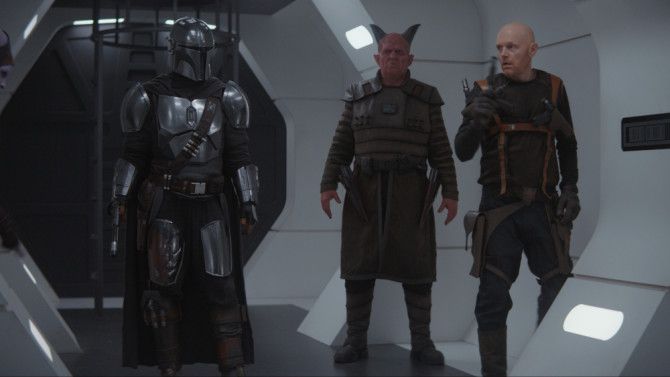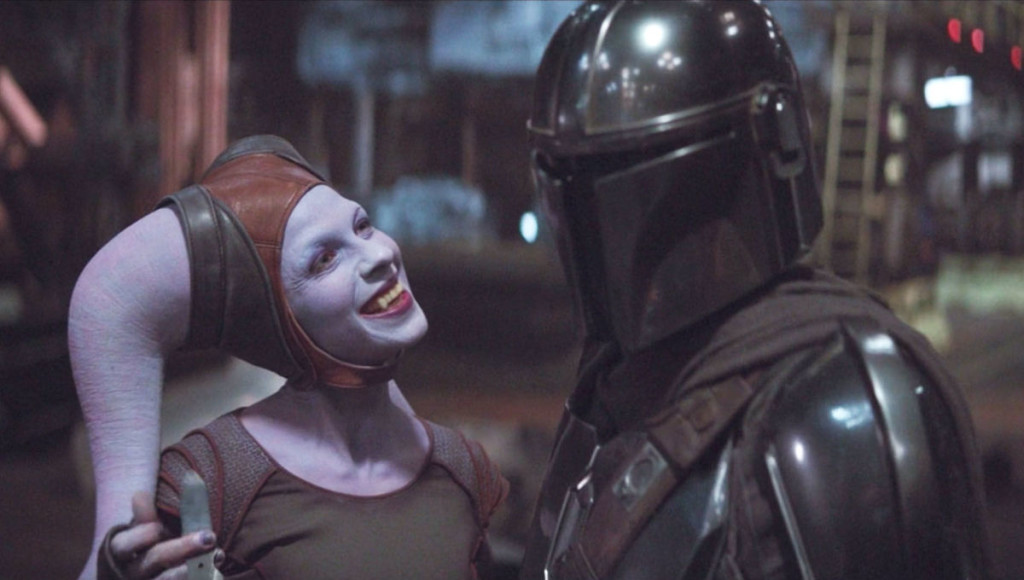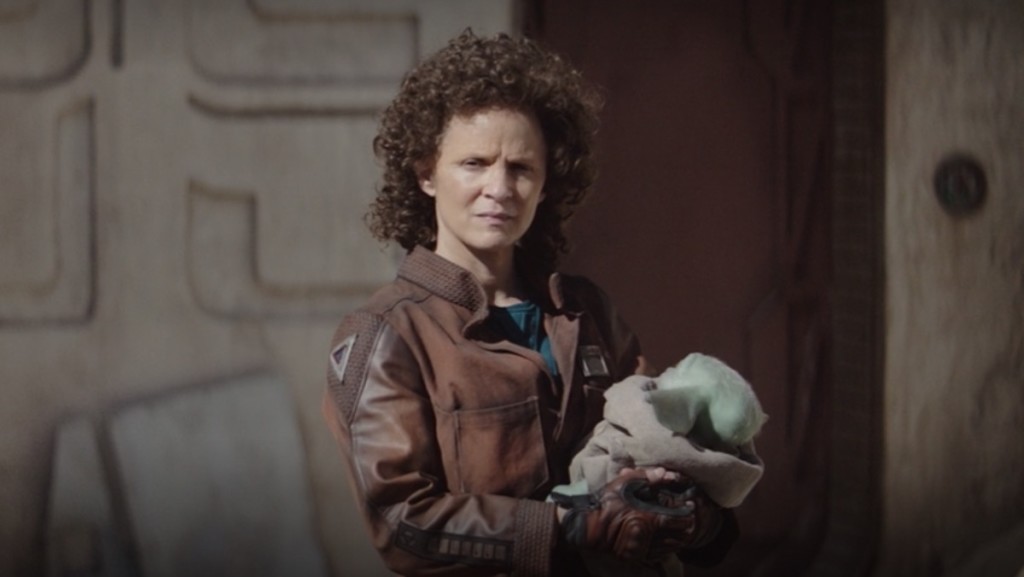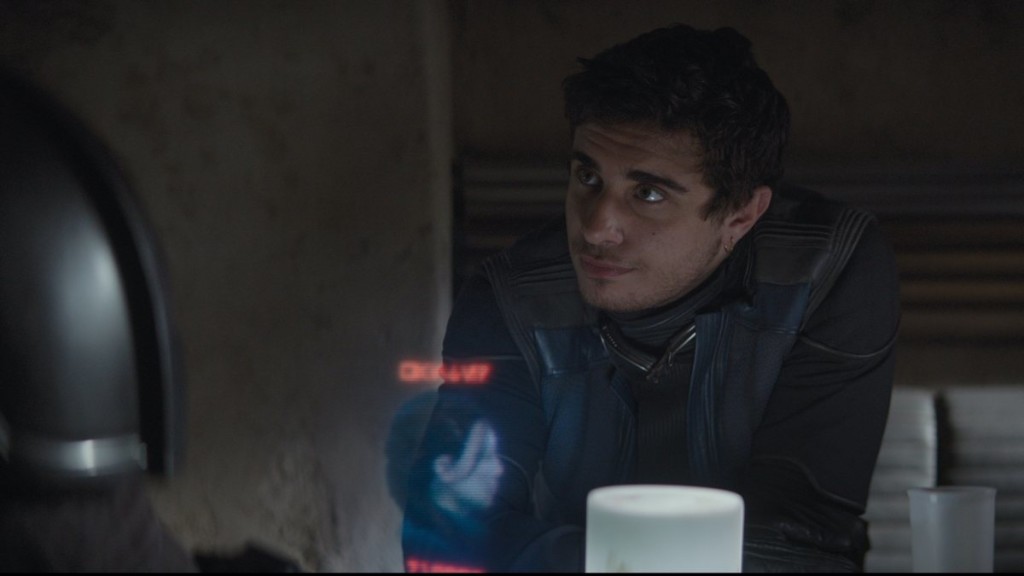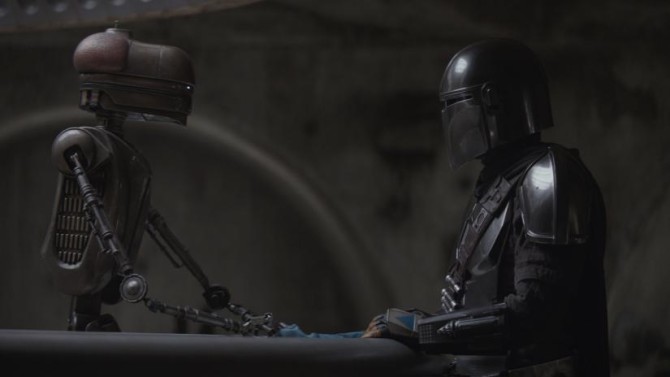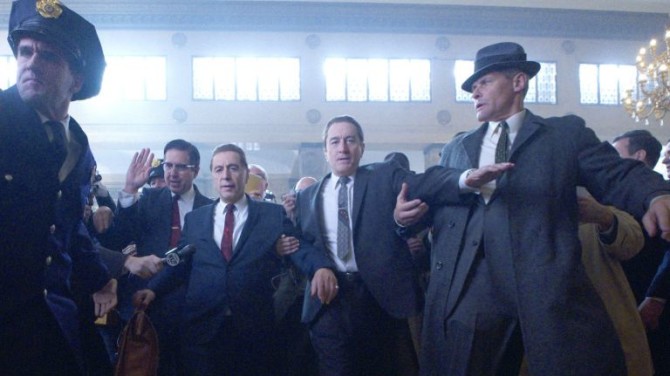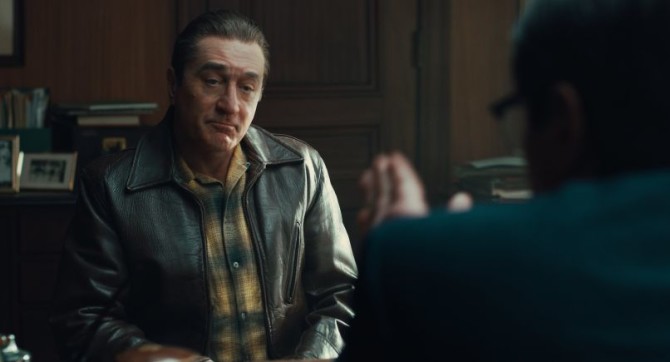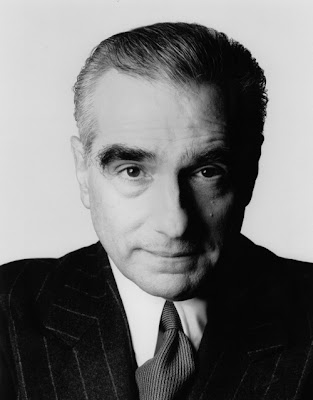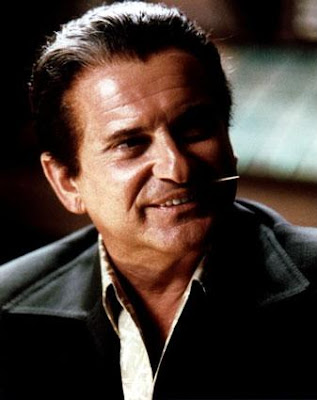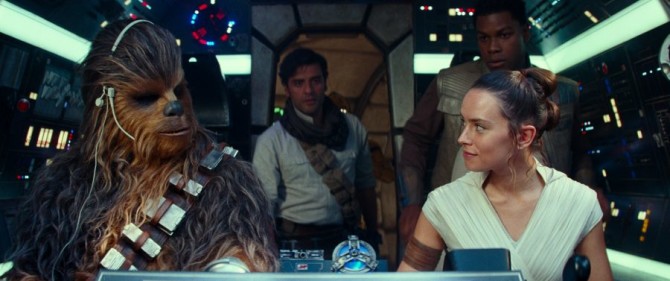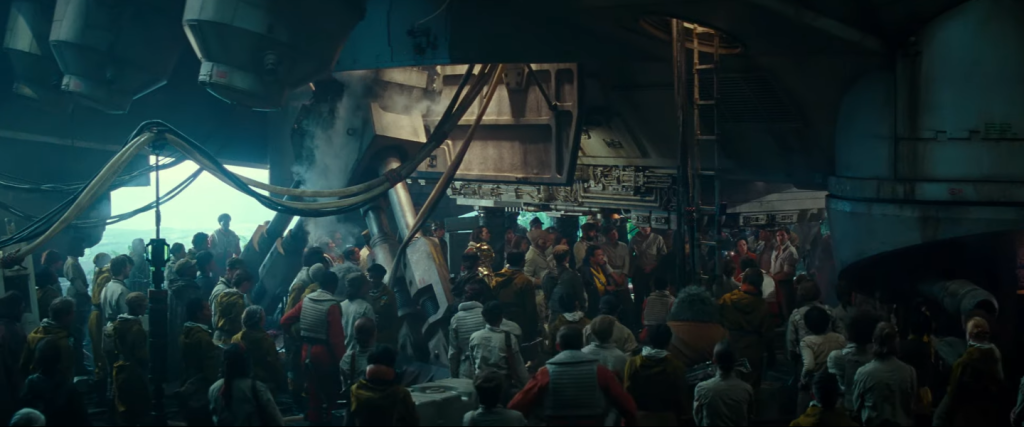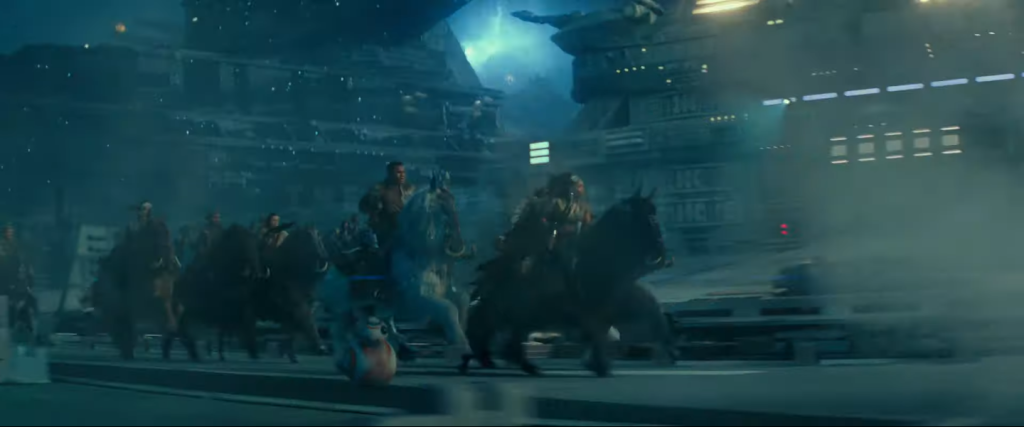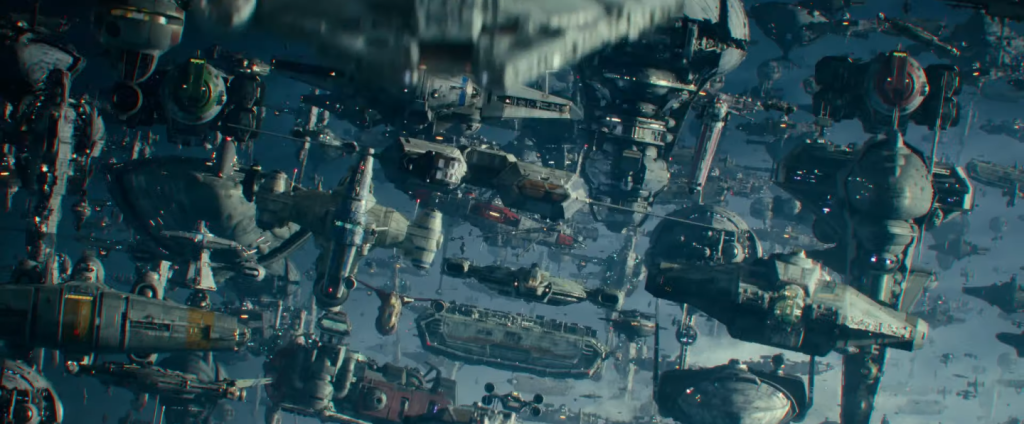Search Results for: the wall
Welcome to The Mandalorian Teleplay Chronicles. I will be reviewing every episode of The Mandalorian’s first season with an eye towards helping writers learn TV writing. Here’s a link to my review of the first episode here, a link to the second episode here, a link to episode 3, episode 4, and episode 5.
Genre: Sci-Fi Fantasy (Half-Hour Drama TV??)
Premise: This week, Mando teams up with four fellow bounty hunters to spring a prisoner from a prison ship. In the process he learns that they plan to leave him behind.
About: We are six episodes in. Before this episode, we had two good episodes and three bad ones. The good news is the Rick Famuyiwa, who directed my favorite episode of the series (Episode 2 – Jawa Adventure), is back in the director’s seat. This week, he’s also writing, which is good news if only because it means he’s taken Dave Filoni out of the mix. Famuyiwa is joined by Christopher Yost, who penned Thor Ragnarok. Heads up for Mandalorian fans. Next week’s episode comes out Wednesday. Then they’re off for a week. Then the final episode is on the Friday of the week after.
Writers: Rick Famuyiwa and Christopher Yost
Details: 40 minutes? 42 minutes? (the credits are 80 minutes long every episode so it’s hard to determine the actual run time of these things)
I’m done with this show.
I mean, I’ll watch and review the last two episodes. And I’m sure they’re going to add some cliffhanger at the end of the season (Boba Fett? Jabba the Hut’s son?) that will make me check out the first episode of Season 2. But after that, I’m done.
This is not what I was hoping for at all. I thought we were going to get an expansion of the Star Wars universe with new and fun interconnected storylines. Instead we get this cartoon format “adventure-of-the-week” b.s. Literally 99% of the people who watch this show want an interconnected story. But of course that’s not the way Lucasfilm operates. Give the fans what they want?? Hezell no, that would make sense. We’ll make the Star Wars we want to make and you’ll suffer for it.
Some of you may say that I’m just mad that they didn’t give me what I was expecting. No no no. They legit hoodwinked us. They introduced baby yoda and this mysterious cloning guy – implying that we were entering a larger season-long story. Now Baby Yoda is nothing more than a meme. His inclusion in each episode is a strain. He’s a plot point that needs a character to say “You stay here” for 30 minutes while the episode happens.
And Friday’s episode? Friday’s episode was not Star Wars. Friday’s episode was Deep Space Nine Wars. It was Star Trek, complete with bad make-up and awful acting (the devil guy and purple girl especially). That’s another thing. I never watched an episode of Game of Thrones and thought, “They skimped on money there.” Yet I was constantly annoyed by the cheap production value in this episode. They built the entire episode around a single freaking hallway! They built ONE HALLWAY and kept running around in it.
For those who didn’t see the episode, count yourselves lucky. It follows Mando as he reconnects with an old terrible actor who always seems to arrive on a show’s worst episode. I remember this actor when he appeared on Lost and screwed up a few episodes of that show. Anyway, he puts together a team for Mando to go break a prisoner out of a prison ship. The team consists of Bill Burr, Twi-Lick, Devil Man, and Zero Bot.
They infiltrate the ship, go break the guy out, and we learn that the prisoner is Man Twi-Lick, the Twi-Lick woman’s brother! Somehow Man Twi-Lick’s makeup is even worse than his sister’s. Then, wouldn’t you know it – they turn on Mandalorian! Locking him up. They *could* just leave, of course. But no, they hang around for a bit, allowing time for the Mandalorian to escape and then hunt them down one by one. The end.
Last week, in the comments, I was arguing with a reader about isolated episode TV versus storyline TV. My argument was you should write something that connects. Almost EVERY SINGLE SHOW on TV today has a through-line.
Why? Well, you have to remember why they did it differently back in the day. It was because there wasn’t a medium that allowed people to re-watch shows. The only time a show was on was when it came on TV. If you missed it, you missed it. TV execs back then were worried that if someone missed an episode and that episode was critical to understanding the show, then the next episode would be confusing, dissuading the viewer from watching future episodes. The solution was to make every episode its own isolated thing (this is why sitcoms used to be so huge – they were ideal for this format).
But then DVDs came along and people were buying entire seasons of shows and so it made sense to create more of a through-line from show to show. Then the game really changed when Lost came out. That was the first show where you had to watch every single episode to know what was going on. After that, the further advent of “watch a show whenever you want” occurred when streaming arriverd. Breaking Bad and Game of Thrones became mega-hits specifically because you had to watch every episode to find out what happened.
Long story short, making The Mandalorian an “every episode is a standalone episode” show makes no sense. ESPECIALLY because it’s Star Wars, the biggest fictional world ever created. Why are you doing this? It makes it feel like a Saturday Morning cartoon, which it ISN’T. It’s a live-action 20 million dollar an episode show. Not only that, the seasons are SHORT! You don’t have to come up with a 20 episode arc here. It’s just 8 episodes! You can’t connect 8 episodes??
It’s frustrating and it’s maddening and it’s sad. It’s sad because this show is going to die. Probably not this season. But next season for sure. It’s been exposed. Everybody who talks about it says the same thing. “Yeah it’s kind of good… um… but why aren’t the episodes longer and why isn’t the story connecting?”
And look, if every episode was actually good, we’d be having a different conversation. If you somehow made this archaic format work for the show, I’d be all for it. But this isn’t Saturday Morning Cartoons. You have a rabid fan base desperate for a Star Wars with substance and you’ve given them the opposite. I don’t get it. I don’t get how they could’ve miscalculated so badly.
But okay, let’s get at least SOME writing tips from this abomination of an episode. What you have in today’s episode is a heist plot. A group of guys go in and try to retrieve something from a place where it’s theoretically difficult to retrieve that something. So that’s what we’re critiquing. Did they do a good job of executing that story?
I’ll start by saying this. A lot of writers will tell you that heists should never be about what’s being taken. That it should be about the characters and how they go about getting the job done. This is bad advice and I think I know where it comes from. It comes from the fact that all heist plots used to be about money. And money is boring. So it would make sense to say it shouldn’t just be about the money.
But heists have evolved over time and now heists can be about retrieving anything. That’s something you should take advantage of. Cause it means you can use the object being retrieved as a means to manipulate the plot. And what I like about this setup, in theory, is that by making the heist a prisoner, you’ve got more to work with in terms of plot evolution. You can make the prisoner a surprise. The prisoner can also have their own plans, want to do their own thing that doesn’t line up with the heister’s plans. So the setup to this episode isn’t a bad one.
But one of the principles of good writing is to find something new in an old setup. So if you’re going to be the 800,000th person to write a heist show/movie, you should add a new idea to the mix. There was none of that here. The execution here was so basic — THERE WAS ONE HALLWAY! — that we were ahead of the show the entire time.
One of the ways I measure good writing versus bad writing is to ask, “Is this something the average amateur writer could’ve come up with?” And the answer with this episode is undoubtedly yes. There is literally nothing in this episode that Joe Schmoe over at the Grove Starbucks couldn’t have come up with. It follows the beats so religiously that it’s practically begging to disappear the second it’s over.
And if that isn’t bad enough, there is ZERO resistance in this plot. There is never a doubt that they’re going to be able to get the guy out. These Battlestar Galactica droids were about as menacing as a can of Raid. Now some of you may say, “Well, how difficult really was it for the characters in the original Death Star?” I remember specifically feeling like they were f&*%d in that trash compactor. There’s one shot in particular where the walls are coming so close to each other that the edge of the moving wall starts covering the frame. I was legitimately worried that they weren’t going to make it.
That never happened here. Not once.
Then, on top of that, the show is way too short for this kind of storyline! This is the whole reason why you need to be connecting your storylines. You’re trying to set up six brand new characters AND create an entire heist story in 40 minutes?? Come on. Look at yourself in the mirror. Be real. If you’ve been building up to this for two episodes, you’re golden. But squeezing it into one episode? It’s disaster sauce.
One of the clearest examples of this is when Mando gets locked in the cell. The show is so short that they didn’t have time to establish that he was stuck there before they had to write a scene of him breaking out. And the problem with that is, if you don’t first establish that he’s REALLY STUCK THERE, that it’s GOING TO BE DIFFICULT TO GET OUT — maybe he tries a few things and they don’t work — if you don’t do any of that, then it feels too easy when he gets out. We don’t feel like he’s earned it at all. It’s only happening because the plot needs it to.
In retrospect, it’s clear to me that Favreau wrote those first three episodes as a self-contained story and didn’t have a plan afterwards. And we’re seeing that play out here. Each episode is less and less connected to the previous ones. And that’s too bad because Rise of Skywalker comes out Friday and it’s looking iffy. So I was hoping this series would take the Star Wars mantel and give us the great adventures and cool stories that Star Wars fans deserve. That isn’t the case.
[x] What the hell did I just watch?
[ ] wasn’t for me
[ ] worth the stream
[ ] impressive
[ ] genius
What I learned: One of the biggest misconceptions is that the “bunch of bad guys joining together to go after something” is a slam-dunk show/movie setup. Just like any idea, you still need to do the work to make it work. You still need to create original characters that we’re interested in. You still need to make the heist itself unique in some way. You still need some genuine surprises along the way. A lot of people point to the fact that The Dirty Dozen was so great. But how many versions of that setup have been awful since? Way more than have been successful. Does anybody remember Suicide Squad? Never ever rest on your concept. You are starting from a better place than a lame idea – you’ve got that going for you. But you still have to put everything you’ve got into the story and characters if it’s going to shine.
Welcome to The Mandalorian Teleplay Chronicles. I will be reviewing every episode of The Mandalorian’s first season with an eye towards helping writers learn TV writing. Here’s a link to my review of the first episode here, a link to the second episode here, a link to episode 3 and here’s episode 4.
Genre: Sci-fi/Fantasy
Premise: The Mandalorian gets stuck on Tatooine where he must help a young bounty hunter pursue a dangerous assassin.
About: This is Episode 5 of The Mandalorian. Only three episodes left! Star Wars trivia maven Dave Filoni is back in the driver’s seat. But unlike the pilot episode, he’s not just directing here, he’s writing too, making this the first episode not written by Jon Favreau.
Writer: Dave Filoni
Details: 30-35 minutes.
“Mando!”
I love the way Carl Weathers calls out to the Mandalorian. There’s something vocally pleasing about mimicking the way he says it.
But I’ll tell you what I don’t love.
Dave Filoni’s writing.
This episode is about what you’d expect from the Star Wars Trivia Guy. A jaunt down memory lane. Lots of old Star Wars lines and Star Wars spots. It’s a fan service party. I’m sorry but Filoni needs to be placed back in the cartoon side of Star wars. He works best in situations where he can give characters pink helmets and have everyone say, “I have a bad feeling about this” twice an episode.
I’m tempted to spend the next 2000 words ripping this episode apart, but I want to stay true to the purpose of these articles and focus on improving our television writing.
For those who didn’t see the episode, here’s a recap.
After Mando injures his ship in a space battle, he flies down for repairs on Tatooine! You know, from the original Star Wars! Once he lands, we meet the extremely cartoonish Rhea Pearlman who I know isn’t Rhea Pearlman but I’m going to call her Rhea Pearlman. Rhea Pealman is a space port mechanic or something. She tells Mando she can’t fix his ship without deniro and Mando doesn’t have any. Uh-oh. What’s a bounty hunter to do?
Mando leaves Baby Yoda and his viral memes in the ship to grab a beer at, you guessed it, the Cantina bar from Star Wars! There he meets Toro Calican. If that’s not a fan fiction Star Wars name, I don’t know what is. I bet I could find a better name on one of those Star Wars name generator websites. Actually, I’m going to test that theory. Hold on. ——- Back! Here’s the first one they gave me: Thes Lerann. Already better.
Toro Calican, played by someone who took his first acting class last week, is sitting in the exact seat where we first met Han Solo and even sits the same way Han Solo does!! Toro is a young bounty hunter who needs help with a bounty out by the Dune Sea (THE DUNE SEA!? WAIT, DIDN’T LUKE REFERENCE THE DUNE SEA IN THE ORIGINAL STAR WARS!?!?). He says he’ll split the payout with Mando, which will allow Mando to pay for his ship repairs and blow this joint.
They head out to the Dune Sea and get in a sniper battle with the assassin. Realizing they need to get closer, they wait til night and use flash-bang explosions to blind her gun site. This makes it so she can’t shoot them as they approach. Eventually they capture her and she smooth-talks Toto Barnacle into going after Mando. Fortunately, Mando sniffs it out and defeats Toto first. The end.
Oh, and then there’s a cliffhanger where we see a random character’s feet.
The big problem with this TV series right now is that the show doesn’t seem to be going anywhere. When you’re writing serialized television, you want to connect the episodes as much as possible. You want multiple characters pursuing multiple things. You want unresolved conflict between characters. You want overarching goals, immediate goals. You want new relationships to form, old ones to fall apart. You want conflict at every turn. And you want it all to exist within a giant web of connectedness. All of this helps your show feel like it has purpose.
So it’s strange that The Mandalorian is doing the opposite of all these things.
Each episode is singular. Not only in its mission, but with its characters. The press tour for this show focused on all of these actors who were going to be a part of this series. But so far, all of them are only getting one episode. It’s bizarre.
We continue to watch because we’re Star Wars fans and this is a new way to enjoy the franchise. But they need to get their bantha s%$# together. What is the ultimate goal of this show? There’s no big bad guy. There aren’t any real unresolved conflicts between Mando and other characters. Maybe Greef Carga, but come on. He’s had 5 minutes of screen time.
And that’s another issue with the show. Every drama I’ve ever known has been in that 48 to 60 minute length. The reason for that is that dramas are about character and it takes time to develop characters. You have to experience them in a lot of different situations and witness a lot of their conversations in order to connect with them. We’re not doing any of that. When you combine that approach with these short individualized [side] quests, the experience feels as empty as talking to a droid.
It’s funny because one of the things I was worried about going into this series was whether Star Wars could work as a “talking heads” show. Yet here I am now begging for more talking heads. If we’re not invested in multiple character storylines in a show, we’re eventually going to tune out. Focusing on a single hero’s storyline is a feature game. This is television.
Okay, back to Filoni. Everything in this episode from the characters to the dialogue was cheesy and cartoonish. However, if you look back at the original Star Wars, you could argue that it’s cheesy and cartoonish as well. A major storyline in the second film is a man hunched over in a tiny hut talking to a green frog creature who speaks backwards. But the original Star Wars is still a thousand times better than this episode. So there’s a clear line between good cheesy and cartoonish and bad cheesy and cartoonish. Where is that line and how do you know if you’ve crossed it?
I think it’s a matter of degree.
If you create overly goofy characters, it’s hard to rein them in to anything approaching authenticity. The two characters Filoni introduced into this episode were Toto Barnacle and Rhea Pearlman. Rhea is WAAAAAY over the top. And Toto is WAAAAAY cheesy.
Interestingly, they’d probably work well in a cartoon. Cartoons embrace exaggeration whereas live action requires a sense of grounded-ness. Cartoon characters don’t possess the necessary depth to make you believe that they exist outside of the moments we see them. For example, can you imagine an average day with the Rhea Pearlman character? Of course not. She wasn’t constructed to exist in real life. She was constructed to bounce off the walls and give Mando dime store life lessons in five minutes of screen time. If you want characters who feel like real people (or real aliens!) you need to think of them beyond the scenes that you write for them.
And, actually, a great exercise is to sit down and write a typical day that your character goes through. Once you’re forced to think about the mundane moments of your character’s life, that’s when you really start to understand them. Filoni clearly hasn’t done that. And that’s why Toto sounds so cliche. You can’t get original lines out of a cartoon character. You only find original dialogue through a fully lived life.
That friend of yours who always seems to come up with the funniest most original observations – that didn’t come out of nowhere. His extensive life experiences shaped his reality and, over time, all of that built into a unique world view. It’s the same thing with characters. The more you know about them, the deeper the well there is to pull dialogue from. The less you know about them, the more you’ll rely on cliches. This is a monster point so I want to stress it:
The majority of generic and/or cliche dialogue comes from a lack of understanding of the characters speaking. The more you know about someone, the more specific their lines will be, moving you further and further away from cliche.
If there’s one thing I want you to take away from this misadventure, it’s the importance of character in television. Spend more time coming up with your characters. Try to get to know their pasts as much as possible. Think about the relationships of your characters in your show. Make them complicated and interesting and full of unresolved conflict. Think about their individual storyline throughout the season and think about how it will weave in and out of other characters’ storylines. And think about the arcs of your supporting characters. In features, it’s all about the hero. But in TV, everybody needs to arc and so everybody needs to be on their own difficult journey. That’s not happening in The Mandlorian, and if it doesn’t start happening soon, this show is in major trouble.
[x] What the hell did I just watch?
[ ] wasn’t for me
[ ] worth the stream
[ ] impressive
[ ] genius
What I learned: One of the reasons I’m not a huge Stranger Things fan is that, like The Mandalorian, they depend too much on fan service. Everything is a reference to something else. I like it when writers do the hard work and come up with fresh ideas. However, the one thing Stranger Things has over The Mandalorian is that it cares a lot more about character development. There’s a real desire to get to know what makes those characters tick that I’m not seeing in this show. You can only get by for so long on plot in TV. Sooner or later, you have to let us into multiple characters’ lives.
What I learned 2: Singular POV doesn’t work well in television. The Mandalorian is a Singular POV TV show. We see every scene through the hero’s eyes. The reason this is so hampering is because television depends heavily on great characters and if we’re limiting the point of view to just one person, we’ll only get to know the other characters through the limited point of view of our hero’s eyes. I mean even Star Wars cuts around to different points of view and that’s a feature. This is a strange choice that’s slowly killing the show.
Genre: Crime/Period
Premise: An Irish hitman joins the Italian mob, allowing him to meet Jimmy Hoffa, who he develops a deep friendship with.
About: After 10 long years of development, Scorsese’s latest passion project, The Irishman, is here. Unable to get studios interested in a 150 million dollar flick that didn’t have superheroes in it, Scorsese turned to former enemy Netflix to make the film, who was all too happy to bankroll another shot at their current obsession – a Best Picture Oscar. The film’s sky-high budget is due mostly to de-aging its trio of stars, Joe Pesci, Al Pacino, and Robert DeNiro. Here’s my old review of the script.
Writer: Steve Zallian (based on the book by Charles Brandt)
Details: 3 hours and 30 minutes long!
The Irishman is a weird movie.
Its biggest expense – the de-aging of its actors – is so unimpressive as to make you wonder why they went through all the hassle. The idea was strong in theory. Use new technology to turn back the hands of time and give us one more performance from three master actors in their prime.
Except when I think of these actors’ primes, I think ages 30-45. Not 55. Yet that was the age Scorsese covered. While I’m not sure make-up and hair could’ve achieved the same effect, there had to be other options. 80 million bucks seems like an enormous expense for what they delivered. If you’re going to spend that money, we need to be truly transported.
Something tells me that if you would’ve aged these guys to 35 instead of 55, this movie would’ve been a monster hit everyone was talking about. We’d truly feel like we were back in the Pacino and DeNiro hey day. As it stands, the whole thing comes off as a curiosity, an old dog trying new tricks and not executing them well enough to earn a treat.
If the 3 and a half hour running time of The Irishman scared you off, here’s my TLDR. The movie follows a guy named Frank Sheeran, an Irishman who became a hit man for the Italian mob. He took care of people whose interests weren’t aligned with his employers. Sometimes that meant people outside the mob, sometimes it meant people inside.
Big boss Russel Bufalino (Pesci) takes a liking to Frank, and the two work in tandem with Jimmy Hoffa, the teamster leader who has more power than the president of the United States, to rule the roost in the 1960s. But when they get greedy, the government comes after them, and all three end up in prison at one point or another.
When Hoffa gets out, he wants to be reinstated as teamster president. But that ship has sailed. Unable to accept this arrangement, Hoffa keeps pushing and pushing until Bufalino’s had enough and orders Frank to kill him. Frank drives him to an empty house and shoots him in the head. They then burn Hoffa’s body. Frank is conflicted since Hoffa was a friend but this is the life he chose. This is the bed he must lie in.
All of this is told in Scorsese’s trademark MONTAGE-VOICE OVER style, using an older Frank to narrate the events for us. This allows us to speed through years at a time when needed and get full-on bios of the movie’s endless cast of characters.
Something I realized while watching this style is that it’s perfect for big sprawling stories. One of the reasons I always tell you to keep your stories as contained as possible is because contained stories are easier to manage. The more sprawling things get, the harder it is to wrangle it all in in a cohesive manner. Of particular importance is pacing. It’s hard to keep the pace up if you’re randomly jumping forward years at a time. Scorsese’s never-ending voice over montage helps keep these traditionally slow transitions crackling along.
As far as how the script changed since its initial draft 10 years ago, I’d say it both changed a lot and yet not at all. The overall feeling of the movie is EXACTLY the same as that early draft. All of this is exactly how I pictured it would look and feel. But they made some wise choices, like de-emphasizing the plot line where Frank and Hoffa drive to a wedding together. Scorsese seemed to realize, either in the script or in the editing room, that nothing much happened in that storyline, and that the stuff in the past was where it was at.
Another change made was giving a bigger storyline to Frank’s oldest daughter. I’m guessing this choice was made specifically because Scorsese is often critiqued for not providing enough strong female roles in his movies. It was a surprisingly effective plot line, especially the stuff where Bufalino became increasingly upset over the years because Frank’s daughter was the one person on the planet who didn’t like or pretend to like him. Anna Paquin’s nearly dialogue-free performance was one of the most memorable in the film for me.
Conversely, the most disappointing thing about the film were the performances of the big three. They were all nice. But you’re not going into a Pesci, DeNiro, Pacino movie looking for “nice.” You’re looking for great, performances you’re going to remember for the rest of your life. We didn’t get that. One of the most surprising choices was that none of the characters was given a “chews up the scenery” type character to play. Everybody was various levels of reserved. Bufalino was extremely reserved. Frank was fairly reserved. And even the king of overacting, Pacino himself, played Hoffa reserved most of the time.
This robbed the characters of any contrast between one another. If you want great dialogue and great moments, you need contrasting characters. And with everyone so chilled out here, we rarely got that. Some of the better scenes with the three came late when Hoffa began losing his cool. It’s not surprisingly why. The more he lost his cool, the more in contrast he was with Frank.
For that reason, Irishman had to look elsewhere for its good scenes, and my favorite came when Hoffa had to ask rival Tony Pro for his endorsement to get back the top position in the union. The last time we saw these two, Hoffa told Tony he wouldn’t be getting his million dollar pension. Tony then shows up late for the meeting, which pisses Hoffa off, who tells him he wants an apology for showing up late. It only gets worse from there. It was these moments where The Irishman shined brightest – where one person needed something from another and there was all this s#$% in the way that made it difficult. As a writer, tension needs to be one of your best friends. Treat him well and he’ll give you some of your best scenes.
One final beef I had with the script was the lack of a clear narrative for Frank. The title of this movie is “The Irishman” and yet, if you didn’t know that, you wouldn’t have known Frank was Irish. Or that being Irish in this world even mattered. If I remember correctly from the script, Frank’s dream was to become a mob boss. He wanted to get as high up into the mob hierarchy as possible. That goal gave his character purpose and it gave the audience an opportunity to participate.
That’s what a good character goal does – it recruits the audience to root for the hero to achieve what they want. Since we didn’t get any targeted storyline about Frank wanting to be the first Irishman to lead the mob, Frank’s character felt more like an unimportant drifter, a dude who was called upon when an important hit needed to be made. Otherwise, go stand by the wall and shut up. A narrative more focused on him climbing the ranks and getting pushback due to his non-Italian roots would’ve elevated this movie considerably.
And one final problem this movie has that not many people are talking about is there was another movie that came out this year which also faithfully placed us back in the 60s that did everything The Irishman did, just better. That movie, obviously, was Once Upon a Time in Hollywood. Pitt’s and DiCaprio’s performances were so much more fun to watch than these three.
All of this is not to say I didn’t enjoy The Irishman. But to say that the film didn’t meet my expectations would be an understatement. It needed one of these guys – just one of these guys – to give a great performance. And because that didn’t happen, I’d say that this film is best enjoyed as a passive viewing experience while you mess around on your computer for four hours.
[ ] What the hell did I just watch?
[ ] wasn’t for me
[x] worth the stream
[ ] impressive
[ ] genius
What I learned: Look for contrast in the characters who are going to have the most screen time together in your script. If the characters are even a little alike, you’re going to run into a lot of scenes where you’ll find it hard to bring the dialogue alive.
With The Irishman just having come out on Netflix (I haven’t seen it yet – will check it out this weekend), here’s my review of the screenplay from a few years ago! Can’t wait to find out how it’s changed. Will probably do a script-to-screen on Tuesday.
Genre: Crime Drama Biopic
Premise: A mob hit man recalls his relationship with one of the most well-known mobsters in history.
About: “The Irishman” is based on the book “I Heard You Paint Houses” by Charles Brandt. It’s a hot project due to Martin Scorsese potentially directing the all-star team of De Niro, Pesci, and Pacino. Steven Zallian, who adapted the script, is one of the best writers working today. His credits include American Gangster, Gangs of New York, Mission: Impossible, Clear and Present Danger, and Searching For Bobby Fischer. Of course, he won the Oscar for Schindler’s List back in 1993.
Writer: Steven Zallian (based on aforementioned novel by Charles Brandt)
Details: 135 pages – Draft 1-5, Sept. 15, 2009
The Irishman is yet another Scorsese foray into the criminal underworld, this one taking place in a period he knows nothing about: the 70s. The story isn’t truly based in the 70s. Scorsese, lover of flashbacks that he is, actually flashes back inside his 70s flashback film to the 1950s, where the bulk of the plot takes place.
Our real life hero is an average guy named Frank. Frank tells us (in classic Scorsese voice over) how sucky it is having to kill people, particularly people you know. Due to the friendship, you must master a cadence by which they don’t suspect you’ll kill them. As soon as they suspect you, they’re capable of anything, and all bets are off. So stay calm, wait for them to turn their back, and bang bang. Problem solved.
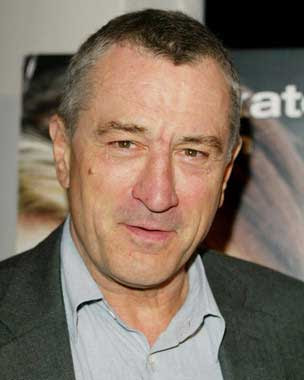
After explaining the art of the kill, we meet Frank’s good friend, Russell Bufalino. Bufalino wants Frank to join him on trip to an old friend’s wedding. Bufalino has some “business” to deal with along the way so he’d prefer to drive instead of fly.
Using this 1970s “present” as a framing device, Frank escorts us into an extended flashback where he tells us how he reached this moment in life. He first learned to kill back in World War 2. He was involved in a major standoff where Germans fired on him for 130 consecutive days. When the Allied forces finally surrounded the Germans, even though they surrendered, Frank shot every pleading German he could because of the hell they put him through.
After the war, Frank took a trucking job, immediately figuring out how to work the system. He’d steal steaks out of his own truck and sell them on the side. This led to him working for Russell Bufalino (the man he’s taking the road trip with in the 70s) who was one of the big heavies at the time. If you’ve seen Casino or Goodfellas, this portion of the screenplay will sound familiar, as passages are almost identical to famous passages from those films. “You wanted to bribe a judge, you asked Russell. You weren’t sure how much to give him, Russell would tell you. You wanted to up one of your guys, he’d tell you if you should. You wanted to get rid of someone – you needed Russell’s permission.”
Where the script really picks up is when Bufalino introduces Frank to Jimmy Hoffa. I had no idea this story was about Hoffa, so watching him show up was kind of like Justin Bieber showing up to your kid’s birthday party. Everything went up a level and all of a sudden it hit me: “Oh shit, we’re going to find out what happened to Jimmy Hoffa!” And indeed, that’s where the story goes.
For those who don’t know much about Hoffa (don’t feel bad – I didn’t know much myself), he became president of the biggest union in the United States and began lending out money to high class criminals from the union’s pension fund. This changed the face of America, as it infused mobsters with boatloads of cash, allowing them to organize crime in a way it had never been organized before. They say Vegas was built with this money.
Hoffa’s story is pretty fascinating (are you paying attention John Wilkes Booth?), so the entire second act is solidly entertaining. For example, Hoffa’s people donated tons of money to back JFK in the hopes that he would help them get back all the casinos they had built in Cuba, which Fidel Castro had claimed for himself once they severed ties with America. Incensed, Hoffa wanted JFK to kill Castro once he became president. Of course, as we all know, that didn’t go so well, and Cuba was lost forever.
In fact, the backing of JFK came back to haunt Hoffa. Kennedy’s brother Bobby HATED him and went after him relentlessly. Eventually, he caught Hoffa on tax evasion and he went to jail for 13 years. During this time, Hoffa wanted a place keeper union leader he’d be able to elbow out as soon as he finished his time. Unfortunately, the man who took his place became super-popular and wouldn’t let Hoffa back in. Hoffa’s insistence that he get that slot back eventually lost him a lot of friends and led to his downfall. Of course, we’re watching all this unfold through Frank’s eyes, and specifically his friendship with Hoffa, who considered Frank one of his closest confidants.
Overall, I really liked The Irishman. While I adore joking about Scorsese’s infatuation with flashbacks and voice overs, I thought they both worked well here. There’s something sorrowful about these old men, driving across Americana, tired, burnt out, brittle, contrasted against their prime, when they were both masters of the universe. The juxtaposition there was perfect. When you combined that with the larger-than-life character that was Jimmy Hoffa, someone I’ve always wanted to know more about, that’s what broke down the wall I usually put up when reading biopics. I mean this is a story that’s fun, interesting, mysterious, suspenseful, dramatic, inventive and challenging. I rarely see a couple of those things in a biopic, much less all of them. Maybe that’s because it isn’t your standard biopic, but that’s a discussion for another day.
My one major criticism of the story is the present day storyline. There just isn’t anything going on in it. They’re driving to a wedding. Every time we cut back to them, they’re still driving to a wedding. There’s no drama there. No conflict. Zallian seems to be using the 70s solely as a “Princess Bride” device – a way to jump forward in the 50s storyline whenever he needs to.
I actually thought the 70s storyline had a ton of potential. In the beginning of the movie, Frank tells us how difficult it is to kill someone you know, so I was sure that was in reference to him having to kill Bufalino. Had we been watching their friendship build over two hours back in the 50s, all the while anticipating Frank having to get rid of him at the end of the trip, that could’ve upped the suspense a hundred-fold. Or maybe we had it backwards, and Bufalino was going to kill Frank. And we’re sitting there wondering who’s going to kill who. It goes another way, and I think that way is ultimately interesting, but it definitely would’ve been nice to have something more going on here.
Where it really hurts the script though is in the final act, since we spend the entirety of that act in the present day. So little has happened in that storyline that it lacks the essential pulse that pushes a story to its ultimate conclusion. It’s hard to describe but those last 30 pages (and we are talking about a long script here, so that contributes to it) feel like the last 60 minutes of a long vacation. Your plane has landed, you’re barely able to stand, you’re waiting for your luggage, and all you want to do is get home and sleep. I’m not sure that’s the way this story should’ve ended.
But hey, on the whole, this was really enjoyable, especially the second act, which as we know is the hardest act to master. Of the four scripts I reviewed this week, I expected to enjoy this one the least, and it ended up being the best by a mile. So for that reason, it’s definitely worth the read.
[ ] What the hell did I just read?
[ ] wasn’t for me
[xx] worth the read
[ ] impressive
[ ] genius
What I learned: Never neglect a storyline. I see this a lot, particularly in this kind of setup where two storylines are going on and one of those storylines carries the bulk of the plot. It’s easy to say, “Well, the 70s storyline isn’t really that important so let’s just make it adequate.” But it’s always better if there’s something interesting going on in the lesser storyline. Even in The Princess Bride, there’s conflict in the Fred Savage/Grandpa storyline because Fred Savage is pretending like he doesn’t care or want to hear the story. That back and forth eventually leads to them becoming closer, giving that storyline a legitimate beginning, middle, and end just like the story he tells has a beginning, middle and end. So I’m by no means saying there needs to be shootouts or excessive fighting in the 70s storyline here – but it would be nice if it wasn’t so benign.
I’ve said it before and I’ll say it again.
This is the single most important Star Wars trailer of all time.
The Star Wars brand was destroyed in the hands of Rian Johnson. Everyone knows it now. Only a few Twitter users on an island try to make the case that it “wasn’t that bad.” Ever since The Last Jedi, the franchise has been stumbling. Solo bombed. An entire trilogy was canceled (Rian Johnson’s). Another one is close to being canceled (Benioff and Weiss). You’ve got Kevin Feige throwing around Star Wars ideas now, as if they’re so desperate for good press they’ll force their way-too-busy Marvel president to make a flick.
And that’s the thing. This trailer doesn’t just have to end the 9 film nerfology. It has to whet the appetite for Star Wars films moving forward. As much as we’ve heard Star Wars is eager to move away from the Skywalker Saga, the truth is, it’s still its best moneymaker. After this, you have to create all new iconic characters that people will want to watch through multiple movies. And if anybody thinks that’s easy, they’ve never written a screenplay before.
To achieve this feat, the Episode 9 trailer needed to be one of the most memorable trailers of all time. That’s not hyperbole. They’re hoping Rise of Skywalker will make 2 billion plus at the box office. To do that, you need to “Star Destroyer level” blow us away. You need to give us moments or shots where we seriously consider putting ourselves in an induced coma so we can get to opening day faster. Now that the trailer is FINALLY out, we have the answers we’ve been looking for.
How did it go?
First, let me share my immediate observations.
The opening shot with the training cap dropped is made to look like it’s Rey. I don’t think it’s Rey and I’ll leave it at that.
The choice of voice over is interesting. I’m not clear on who that is. Is it Poe? I’m sure everyone in the world will know by the time I post this so I’ll accept looking like an idiot. Still, the voice over had a crisper cleaner feel to it compared to previous voice overs, which I found refreshing. Anything to update this dusty franchise!
The first good shot is of the Resistance packed into a room with Lando at the center. I really liked that. Unfortunately, it was followed by an unnecessary shot of Rose which is only there because SJWs start whining on Twitter whenever the Star Wars brand doesn’t feature her.
Next we get the best shot of the trailer – when Kylo emerges from the water with his lightsaber. The shot is turbo-charged by the fact that he’s the only remaining character from the new trilogy who stirs up any emotion in us.
The Emperor segment where we see his chair and we see his ship rise from underground (or is that water?) is pretty cool. I’m into the Emperor returning. I know some people think it’s stupid but due to the Rianator killing off the big baddie in Episode 8 for all of 5 seconds of audience shock, JJ didn’t have a choice. I suppose you could’ve created a new villain. Or maybe matured Kylo into something way worse. But as long as his return makes sense, I’m down with it.
I liked the dolly shot of them running down the corridor. This is where JJ reminds me of a modern day Lucas. He still captures the essence of Star Wars, but adds something a little modern with that fast backwards dolly, a shot Lucas wouldn’t have thought of.
Space horses running on Star Destroyers. Hmmm… Not sure how I feel about this yet. I’d want to know more about the space horses. If you set up their properties as being specifically proficient for fighting in space, I suppose I could get into it. But you’re playing with fire cause if it goes wrong, you end up in Finn and Rose Tico territory where they’re racing those Harry Potter creatures into the wild.
I want to know what Rey and Kylo shatter into a million pieces. It looked like a Vader statue? I don’t know. But I want to know!
There are too many Star Destroyers and too many Rebel ships. When it becomes that many, they no longer seem important. And then, that over-the-shoulder Emperor shot is intriguing because it looks like some sort of mechanical device is moving him. Me like.
The final shot is Rey with her lightsaber and Luke and Leia saying “the force is with you.” Something tells me… and I’m totally guessing here. I don’t have any idea if this is true. That Rey might be a clone of Leia. But that would mean she’s a clone of Luke too, since they’re twins. Hmm… I don’t know. But I feel like we’re going to get one last big twist. If JJ is really going to pay homage to the franchise with this last film, he’d put a shocking personal twist in there somewhere. We’ll see.
So what did I think?
How do I put this.
The trailer isn’t bad. But it takes the wrong approach. This trailer needed to get us excited. Instead, it tried to tug at our heartstrings. C-3PO saying bye to his friends, for example – that moment is trying so hard to tease our tears. In theory, this is the right thing to do. If you can make people feel something, they’re more likely to hook than if you’re giving them a bunch of great shots.
But that assumes you have the emotional pieces to back that up. For emotion to work, it must be genuine. It can’t just be music and Star Wars shots. Case in point, the C-3PO shot I mentioned. He gets all emotional saying bye to his friends yet he doesn’t even know these people. He met them a few weeks ago. So the emotion is false.
JJ would’ve done better to put everything on the table. I heard somebody talking about how awesome it would be if the trailer showed the Emperor open up a lightsaber and then the camera pans over to see Luke Skywalker open up his lightsaber. I don’t think that’s in the movie. But those are the kinds of shots they needed to show here.
The reason we might not be getting them is because JJ doesn’t like to show anything past the first act in his trailers. He’s all about surprising the audience. So I think all this stuff happens in the first act (minus that Emperor shot). The rest of the film is being saved for the movie. Which means they’re overestimating our interest. People are not going into this with the same kind of enthusiasm they’ve had in the past. If anything, they’re going in skeptically. And so not using every single shot at your disposal is like throwing Lebron James in a game and telling him he can only shoot left-handed.
My biggest concern is that the trailer doesn’t have that WOW SHOT. A great trailer has to have that one shot that sells the movie all by itself. The moment Darth Maul opens up his two-sided lightsaber, for example.
This doesn’t have that. The trailer goes all in on Rey. And while Rey has some cachet as a Star Wars character, if you were to rank every Star Wars character in popularity, she’d be lucky to end up in the top 25.
I understand why JJ did this. It’s not like you can start over again. But one of the issues Rian Johnson was too ignorant to recognize was that when he made Rey a nobody, he took a character who was already average-at-best and made her even less interesting. If Rey’s not connected to this lineage, if she’s just some random outsider, why do we care what happens to her? This is the SKYWALKER SAGA.
There are Rian Truthers out there who will tell you, “It’s good that she’s a nobody,” and tout reasons like, “That means anybody can be a Jedi!” But every real Star Wars fan knows these people are wrong. You took a character who needed a PR makeover in the second film to offset the Mary Sue criticism, and you instead made her even less important. It’s kind of baffling, to be honest.
Now maybe JJ does make Rey’s lineage relevant to the story, slamming Johnson’s dumb idea into the wall and shattering it just like Johnson slammed JJ’s Kylo helmet into the wall to shatter it. If he can do that and it MAKES SENSE? I’ll be thrilled. But there’s nothing in this trailer that gives me hope this will be anything other than an average film. And you know what? Maybe that’s a good thing. Now I’ll go into the movie with super low expectations, which will make it easier to enjoy.
What did you think?

